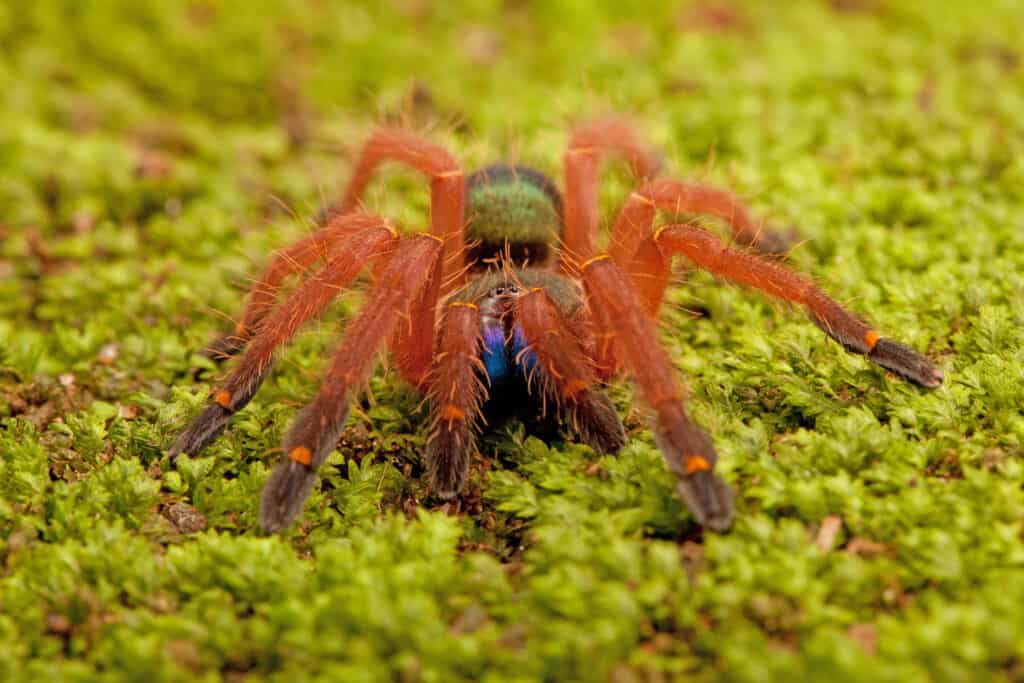Skeleton Tarantula
Ephebopus murinus
Not only are the spooky looking, they get spooked easily!
Advertisement
Skeleton Tarantula Scientific Classification
- Kingdom
- Animalia
- Phylum
- Arthropoda
- Class
- Arachnida
- Order
- Araneae
- Family
- Theraphosidae
- Genus
- Ephebopus
- Scientific Name
- Ephebopus murinus
Read our Complete Guide to Classification of Animals.
Skeleton Tarantula Conservation Status
Skeleton Tarantula Facts
- Prey
- insects, crickets, small lizards, cockroaches
- Main Prey
- insects
- Name Of Young
- spiderlings
- Group Behavior
- Solitary
- Fun Fact
- Not only are the spooky looking, they get spooked easily!
- Most Distinctive Feature
- skeleton-like legs
- Temperament
- Cranky, aggressive
View all of the Skeleton Tarantula images!
“They look like they have skeleton legs!”
Skeleton tarantulas are medium-sized tarantulas that have markings on their legs that look like skeleton bones. Their abdomen is dark brown with a lighter brown carapace; both are covered in spikey hairs called setae. They are native to the northeastern countries in South America. Unlike most tarantulas that are docile and easy going, this species is feisty and aggressive. They have the unique ability to flick their irritating urticating hairs from the front of their bodies.
Amazing Skeleton Tarantula Facts
- The markings on their knees and legs look like skeleton bones.
- Skeleton tarantulas are easily agitated and aggressive.
- They can grow to be 4-5 inches long.
- The males live around three to four years with females living up to 15 years.
- They can flick their urticating hairs from the front in self-defense.
Skeleton Tarantula Scientific Name
The scientific name of the skeleton tarantula is Ephebopus murinus. The genus name Ephebopus is Greek meaning “youthful foot” and murinus is Latin for “grey-mouse-colored.” They derive their common name from their black and white markings. They look similar to stripe knee tarantulas (Aphonopelma seemanni), which are also called zebra tarantulas.
Skeleton Tarantula Appearance
The white lines on the skeleton tarantula’s legs look like the bones of skeletons. The knee area has two white stripes followed by another longer white stripe. The body of the tarantula has a dark brown hairy abdomen and a lighter brown, almost blonde carapace (head section). It looks like they have two additional legs at the front, but these appendages are actually called pedipalps. The skeleton tarantula is the only tarantula that can flick their urticating hairs from the front with their pedipalps. In contrast, other tarantula species that have urticating hairs can only flick them off the back of their abdomen.
The males are a little smaller than the females with the biggest females having a leg span of 4-5 inches. They both have the same coloration and markings, but the males are a little skinnier than the females.

The abdomen of the skeleton tarantula is brown and hairy.
©Linn Currie/Shutterstock.com
Skeleton Tarantula Behavior
Skeleton tarantulas are recognized as feisty and aggressive spiders that get spooked easily. If they feel threatened, they may rear up with their pedipalps flailing and their fangs showing. Then, without much warning, they can charge at you. They are known to be a fast tarantula, especially in comparison to something like an Arizona blonde that seems to move in slow motion.
As mentioned above, if threatened they can also flick their urticating hairs from their pedipalps. These hairs are very irritating when they get stuck in your skin and can cause blindness if they get in your eyes.
Skeleton tarantulas need to molt their exoskeleton to make room for their growing bodies. When they are young, they may molt a few times a year, but as they get older it is less frequent. They wriggle their bodies out of their old exoskeleton, revealing the new one that has formed underneath. During this process, tarantulas typically stop eating, but they have quite an appetite afterwards.
Skeleton Tarantula Habitat
Another unique feature of the skeleton tarantula is their habitat. The young spiderlings start out as arboreal, living in trees. As they get older, they transfer to the terrestrial lifestyle. Adults will make burrows in the ground to avoid the heat in the lowland tropical forest where they live. If not living in a burrow, they may make a webbed nest on the ground nestled between rocks, downed tree branches, or other coverings.
The skeleton tarantula is native to northeastern South America including the countries of Brazil, French Guiana, and Suriname. The tropical forests in these areas are hot and humid, so owners should replicate an enclosure that is moist and around 72°-76°.
Considering their bad temper, it is not a surprise that these tarantulas are solitary animals, living just one spider per burrow. They only come together for the sake of mating.
Skeleton Tarantula Predators and Threats
The skeleton tarantula has several predators, both arboreal and terrestrial. Snakes, lizards, birds, and bigger spiders are all predators of the skeleton tarantula.
The most common threat to skeleton tarantulas is the tarantula hawk, otherwise known as the Pepsis wasp. These large, 2-inch wasps don’t eat the spiders outright, but paralyze them, drag them to a burrow, and inject them with a single egg. The tarantula then acts as a living incubator, keeping the egg warm. It also provides the larvae its first meal when it hatches.
What Eats Skeleton Tarantulas?
Tarantula hawks, lizards, birds, and snakes eat skeleton tarantulas.
What Do Skeleton Tarantulas Eat?
Skeleton tarantulas eat insects, worms, small lizards, small frogs, and cockroaches. In captivity, if you are keeping one as a pet, you can feed them crickets, roaches, and mealworms. After a large meal, they may go for days or weeks without eating.
What is the Conservation Status of Skeleton Tarantulas?
Skeleton tarantulas are not listed by the IUCN as a threatened animal. Their species has not been evaluated by the IUCN at this time.
Reproduction, Babies, and Lifespan
Males leave their burrow in search of a mate when they are around three to four years old. They must carefully approach a female’s burrow. The females may also not be receptive to mating and may choose to eat the male instead. Even if she is initially receptive and allows the male to mate with her, she may eat him afterwards. Males that get away end up dying shortly after mating anyway, so perhaps this is nature’s way of turning valuable protein into support for the females’ reproductive cycle.
Female skeleton tarantulas produce around 50-100 eggs. The females create an egg sac and wrap the eggs with their silky webs, before finding a safe place for them to grow. She may knead the sac and reposition it periodically before spiderlings hatch. Once the feisty spiderlings hatch, they may stay with the mother for a few weeks before taking to the trees. Interestingly, this semi-arboreal lifestyle is uncommon for tarantulas.
The life span of the skeleton tarantula is similar to other tarantulas with the females having a much longer life span than the males. Females can live up to 15 years, but the males only live around three to four years.
Population
The population of the skeleton tarantula is unknown due to their hidden lifestyle. The thick webs that they spin to cover their burrows are the primary evidence of these spiders. Young spiderlings and juveniles also spin thick webs in the trees. The IUCN does not list this species.
Related Animals
View all 293 animals that start with SSkeleton Tarantula FAQs (Frequently Asked Questions)
Should skeleton tarantulas be handled?
No, it is not advised to handle a skeleton tarantula. They are a display pet that you can enjoy while it is in its enclosure. They are too skittish and can flick their hairs at you or bite.
Are skeleton tarantulas venomous?
Yes, they are venomous, but they have a mild venom that is not harmful to humans.
How big do skeleton tarantulas get?
The females are around 2 inches long with a leg span of 4-5 inches. The males are a bit smaller.
Do skeleton tarantulas make webs?
Yes, they make pretty thick webs around the outside of their burrows on the ground. The young spiderlings make webs in the crooks of tree branches and hollowed out trees.
Where are skeleton tarantulas from?
They are native to northern parts of Brazil, French Guiana and Suriname.
Are skeleton tarantulas good for beginners?
No, these are a pet for experienced pet hobbyists. They can be difficult to take care of (and cranky) for a beginner.
Thank you for reading! Have some feedback for us? Contact the AZ Animals editorial team.
Sources
- Tarantulafriendly.com, Available here: https://tarantulafriendly.com/skeleton-tarantula-ephebopus-murinus/
- Empiretarantula.com, Available here: https://empiretarantula.com/skeleton-tarantula/
- Tulsa Zoo, Available here: https://tulsazoo.org/animal/costa-rican-zebra-tarantula/
- (1970)

















